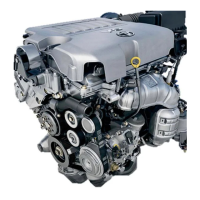ES–310
2GR-FE ENGINE CONTROL SYSTEM – SFI SYSTEM
ES
DESCRIPTION
The ECM continuously monitors its internal memory status, internal circuits, and output signals sent to the
throttle actuator. This self-check ensures that the ECM is functioning properly. If any malfunction is
detected, the ECM will set the appropriate DTC and illuminate the MIL.
The ECM memory status is diagnosed by internal "mirroring" of the main CPU and the sub CPU to detect
Random Access Memory (RAM) errors. The 2 CPUs also perform continuous mutual monitoring. The
ECM illuminates the MIL and sets a DTC if: 1) outputs from the 2 CPUs are different and deviate from the
standards, 2) the signals sent to the throttle actuator deviate from the standards, 3) a malfunction is found
in the throttle actuator supply voltage, and 4) any other ECM malfunction is found.
MONITOR STRATEGY
TYPICAL ENABLING CONDITIONS
TYPICAL MALFUNCTION THRESHOLDS
ECM RAM errors (P0604):
ECM CPU range check (P0606):
DTC P0604
Internal Control Module Random Access Mem-
ory (RAM) Error
DTC P0606 ECM / PCM Processor
DTC P0607 Control Module Performance
DTC P0657 Actuator Supply Voltage Circuit / Open
DTC No. DTC Detection Condition Trouble Area
P0604
P0606
P0607
P0657
ECM internal error (1 trip detection logic) ECM
Related DTCs
P0604: ECM RAM error
P0606: ECM range check
P0607: ECM CPU malfunction
P0657: ETCS power supply
Required Sensors/Components (Main) ECM
Required Sensors/Components (Sub) -
Frequency of Operation Continuous
Duration Within 1 second
MIL Operation Immediate
Sequence of Operation None
Monitor runs whenever following DTCs are not present None
RAM mirror check Fail
Either of following conditions is met: -
Difference between throttle valve position of main CPU and throttle
valve position of sub CPU
0.3 V or more
Difference between accelerator pedal position of main CPU and
accelerator pedal position of sub CPU
0.3 V or more

